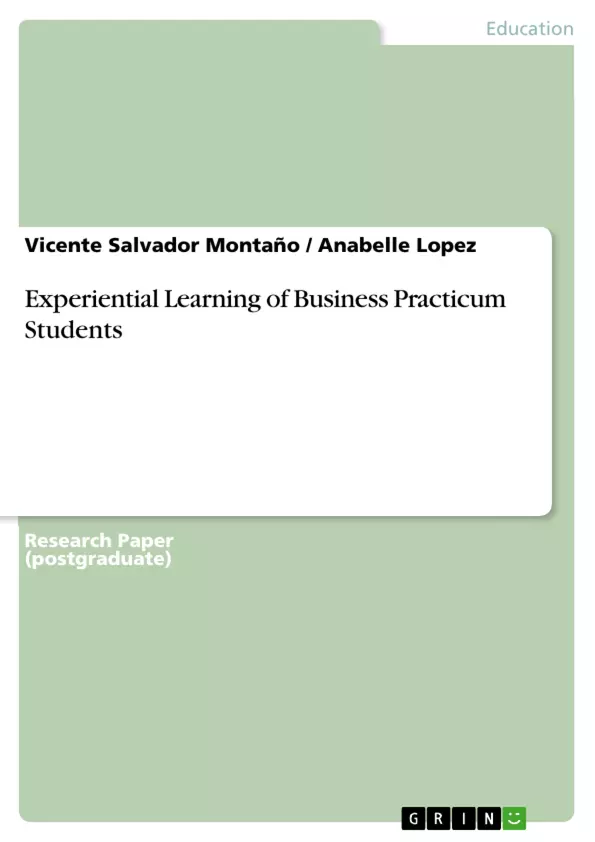This study used the theory of experiential learning to evaluate the business practicum program. Previous research emphasized on the importance of practicum course in the business curriculum; however, the literature was devoid of studies that focus on evaluating the practicum based on the experiential learning of students. One hundred forty five (145) students participated in the study and rated that their practicum program enabled and provided experiential learning.
The factor analysis using the principal component analysis, orthogonal rotation with suppressed factor loading of 0.60 used to evaluate the practicum program. Analysis revealed only three factors, which explained 69.39 percent of the variance for the entire set of variables. The KMO and Bartlett’s test of Sphericity (2255; p = 0) both indicated that the set of variables were least adequately related to factor analysis. The first factor identified as the concrete experience (DO); second factor identified as reflective observation (OBSERVE); third factor identified as the abstract concept (THINK); which explained 59.62, 7.38 and 5.09 percent of the variances respectively. This implied that the business practicum program fell short in completing the cycle through the last phase; testing new situation (PLAN). The study recommended measures for coordinators to complete the experiential learning.
Frequently asked questions
What is the goal of a practicum program?
The goal of a practicum program is to provide graduating students with practical working experience in an actual business setting. It allows students to apply theory, concepts, and skills learned in the classroom and demonstrate generic skills in teamwork, communication, and decision-making.
What are the key elements for a successful practicum program?
Studies show the success of practicum depends on a structured program integrating study and assessment, exposure to career development and business skills, and equal partnerships with host training institutions (HTIs) in training future business leaders.
How is the practicum program viewed globally?
In Brazil, it's called an internship program contributing to their strong incubation ecosystem. In Argentina, small businesses highly regard interns. In Europe, programs are goal-driven with a focus on production and quality management in Germany, and extensive experiences are emphasized in Italy. Asian business schools include practicums to enhance program quality and improve business education. Specific examples are given of programs in Taiwan, Singapore and South Korea.
What are the challenges and issues related to practicum programs?
Early issues were regarding academic supervision, academic credit, and faculty compensation. Later criticism focused on the lack of long-term development through mentoring and the failure to transfer tacit knowledge. Current research investigates post-evaluation of the program and ethical issues concerning the potential exploitation of students.
What is the theoretical framework underpinning this study?
This study is based on the theory of experiential learning, which was initially mentioned by John Dewey termed as "learning by doing." It references Wolfe & Byrne's "experienced-based learning," Vygotsky's "participatory learning approach," and D. A. Kolb's cyclical model consisting of concrete experience, reflective observation, abstract concept formation, and testing new situations.
What were the objectives of this study?
This study aimed to determine the presence of experiential learning factors through the DO, OBSERVE, THINK and PLAN (D. A. Kolb, 1984) cycle in the business administration practicum program. It tried to determine if the current practicum program was enabling the students to apply learned theory and improved skills and establish the presence of a conducive working environment.
What methodology was used in this study?
The study employed a universal sampling method, involving all 145 practicum students from the College of Business Administration Education during the second semester of the school year 2013-2014. Data was collected through a questionnaire administered by the External Relations and Institutional Affairs Office (ERIAO) to avoid biases. Exploratory factor analysis (EFA) was used to determine factors, compliance was ensured by exceeding the 100 participant minimum.
What were the main results and discussions of the study?
Practicum students rated their immersion to different host training establishments as enabling. Exploratory factor analysis identified three factors explaining 69.39% of the variance: Concrete Experience (DO), Reflective Observation (OBSERVE), Abstract Concept (THINK). The business practicum program fell short in completing the learning cycle by lacking the active experimentation phase of testing new situation.
What are the conclusions of the study?
Business practicum students reported that their practicum experience enabled and provided the experiential learning needed in their future professional work. The experiential learning cycle included concrete experience, reflective observation, and abstract concept, but the practicum program lacked a key component of active experimentation to complete the learning cycle.
What recommendations were made based on the study's findings?
Coordinators should enhance experiential learning by requiring students to submit a practicum plan at the start and a career plan at the end of the course. They should promote simulation exercises and ensure students reflect on their practicum experience. Additionally, coordinators should facilitate explicit learning through planning and direction.
- Citation du texte
- Vicente Salvador Montaño (Auteur), Anabelle Lopez (Auteur), 2015, Experiential Learning of Business Practicum Students, Munich, GRIN Verlag, https://www.grin.com/document/338145



